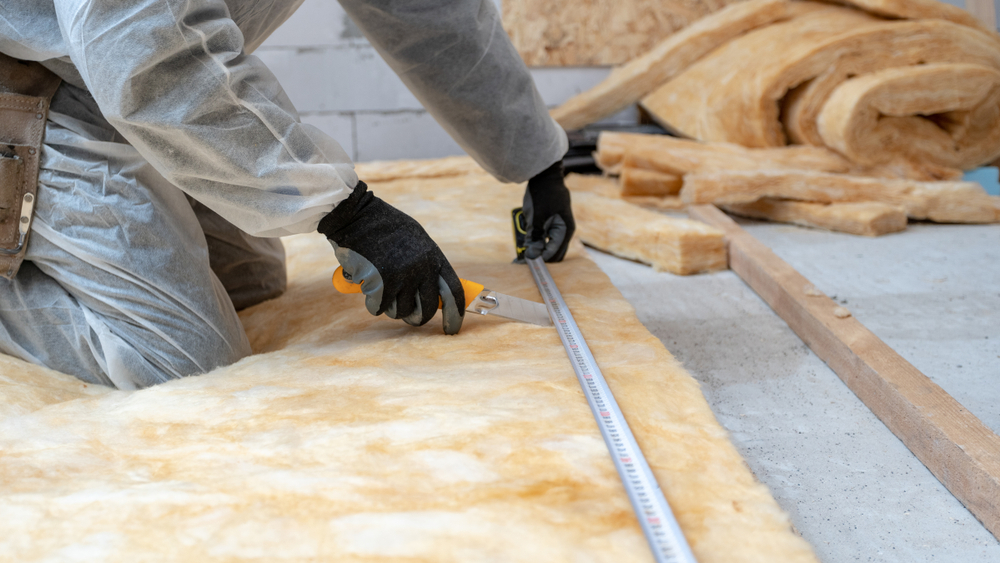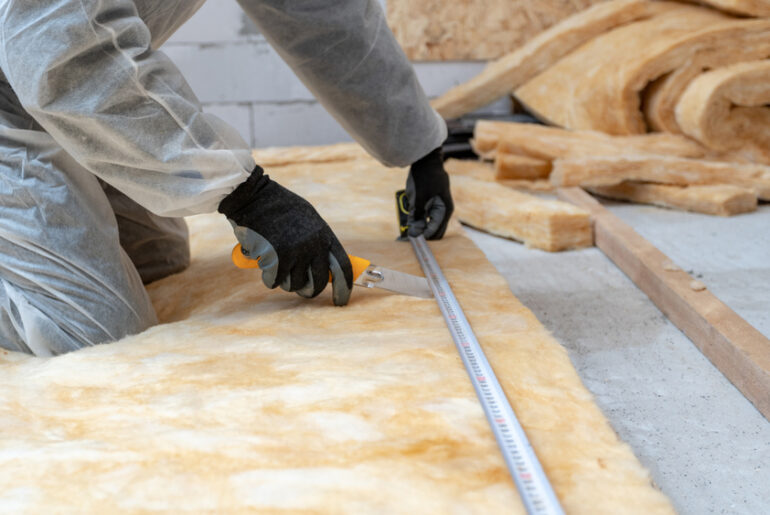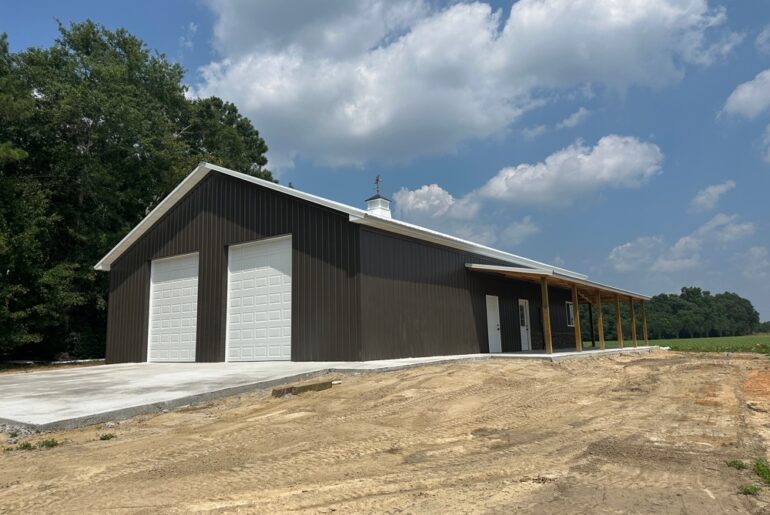Working with fiberglass insulation rolls and batts is relatively simple and requires only a few tools. Faced fiberglass insulation batts allow for quick and easy installation of both the insulation and a vapor barrier simultaneously.
Fiberglass batts and rolls are designed to make installation easier, depending on what is being insulated. Fiberglass insulation is available in a number of designs, widths, and thicknesses to make installation fast, effective, and long-lasting.
Most fiberglass insulation is available in faced batts, which includes the vapor barrier, or unfaced batts, which do not. Thin fiberglass insulation will generally be easier to cut, while wide insulation batts may require lengthwise cuts to fit a certain space.
Here we will describe how to cut insulation rolls, insulation batts, fiberglass duct board, and extra wide insulation using various tools you may already own.
Why Would I Use Fiberglass Batts and Rolls?
One of the great design features of fiberglass batts is that they are available in the same width and length as the location they will be installed into. For example, most walls are 96” from floor to ceiling, so batts are available pre-cut to 96” lengths. Most walls contain 14 ½” spaces between the studs, so batts are available in sizes to precisely fit the opening.
For example, 24” fiberglass insulation is ideal for use with structures built with 2” x 6” walls. Often, these walls contain larger spaces between the studs, which allows for insulation up to 24” wide. The best way to cut insulation will depend on the thickness (R-value), width, and length of the batt.
These manufacturing techniques make installing fiberglass batting easy to install even for a beginner. Most batts also have a flap that folds over the stud, conveniently allowing the installer to fasten two batts with the same fastener. Most fiberglass batts are installed with staples, but button cap nails can also be used.
Here we will describe the process of measuring and making fiberglass cuts. We will also provide a sample list of useful tools to make the project safe and simple. You can never work too safely, so always use the appropriate safety gear for the job.
How To Cut Fiberglass Insulation With Utility Knife
The first step in any fiberglass insulation project is to decide how to measure and cut the batts. Some professionals use large scissors, while others use long-bladed utility knives, or both. You can use any sharp blade, but the blade should be at least 6” long and as sharp as possible.
The process will be the same whether installing the batts into walls, joists, rafters, or trusses. In this example, we will describe the process for installing a batt into a wall.
Step 1. Measure the Batt for Length and Width
Using a measuring tape, measure the space between the studs to confirm it is either 14 ½” or 22 ½”. Most homes are built with 2” x 4” wall studs, but some homes are built with 2” x 6” studs.
Most building codes provide that the maximum spacing for 2” x 4” walls is 16”, while walls built with 2” x 6” studs are often on 24” spacing. We will assume a 2” x 4” wall for simplicity.
Standard residential wall height is 96”, so we will need a batt 14 ½” wide x 96” long. If we purchased the correct batts, each section will be pre-cut for this size. In this case, no cutting of the batt will be required unless there is a light switch or other obstacle in the way.
Step 2. Cutt Notches and Make Adjustments
Eventually, you will encounter a wall void irregularly shaped, so you’ll need to cut the batt. To make the batt narrower, most professionals flip the insulation batt vapor barrier side up (if it has one) on a flat surface. Using a long, sharp blade and a long straight edge as a guide for the knife, they cut through the vapor barrier first and then the insulation.
Many will use a straight 2” x 4” or chalk line to make the mark, but any straightedge will do. The important thing is to cut all the way through the insulation and vapor barrier. If you don’t cut it all the way through, the vapor barrier will likely tear when you separate the sections. The tear may cause an air leak, so use insulation tape to repair the tear if it happens.
Notches are usually best done with insulation shears or other large scissors. You don’t have to worry if the mounting tab is removed to allow for the switch box. Just install fasteners into the stud a couple of inches above and below the box. If you prefer, just transfer the measurements to the vapor barrier on the batt and cut out the notch.
How to Cut Fiberglass Insulation With a Carving Knife
You don’t have to invest in a special knife to cut fiberglass insulation. As mentioned earlier, any sharp, long-bladed knife will do. For example, a typical kitchen carving knife is the perfect length for cutting fiberglass batts.
The only downside is that paper dulls knife blades quickly. Kitchen knives aren’t designed to cut paper, so a carving knife will dull after a few cuts. If a carving knife is all you have and you don’t mind sharpening or replacing it, you can use it to cut fiberglass insulation.
A carving knife will function like an insulation knife, except that most carving knives are serrated. If your carving knife is serrated, be sure it is as sharp as possible to avoid tearing the vapor barrier. Using a non-serrated carving knife is probably the best if you have a choice.
How to Choose A Carving Knife For Fiberglass
When selecting a carving knife from the kitchen, don’t use your favorite. You can easily bend a carving knife because the blade is long. Pick a long-bladed one you rarely use in case it becomes damaged or dulled.
How to Cut Fiberglass Insulation With Common Shears
Cutting fiberglass insulation with shears is probably the easiest method. Insulation shears are very large compared to normal scissors. This design allows them to be used with all types of batting. Insulation shears are usually made from very high carbon steel to retain their sharp edge. As with insulation knives, most insulation shears can be sharpened.
Vinyl Siding Shears
If insulation shears aren’t available near you, you can use most any large style shears. For example, installing vinyl siding often requires trimming around obstacles, but the vinyl can be tough to cut.
Several companies offer siding shears, which often include replaceable blades. Using siding shears is a good option because it’s usually less expensive to replace the blades than to buy new shears.
Hedge Clippers
Another possible option is to use hedge clippers to cut the batting. Hedge clippers open very widely, which is ideal for large batts, like R-30 and larger. Hedge clippers can usually cut through the entire batt in one motion, making the job fast.
However, as with any shears or scissors, the insulation will dull your hedge clippers. Experienced do-it-yourselfers often weigh the hassle and expense of sharpening or replacing the hedge clippers against using disposable blades.
Paper Guillotine
Another tool you can use to cut fiberglass batting is a paper cutter, also known as a paper guillotine. Paper cutters are usually about 20” to 24” wide, which is perfect for cutting fiberglass batts.
A paper cutter may be the fastest method of cross-cutting fiberglass batts because the entire process can be accomplished in a single movement. Especially when many of the batts will be the same length, using a paper cutter can allow one cutter to keep up with up to three installers.
Can You Cut Fiberglass Insulation With Scissors?
You can use common household scissors to cut fiberglass insulation batts. Be aware, however, that doing so will dull the scissors so most DIYers use inexpensive, disposable versions. Ideally, use the largest pair you can find, especially if the insulation is thicker than R-19.
Can You Cut Fiberglass Insulation With A Jigsaw?
Generally, you should use manual tools instead of power tools when working with fiberglass insulation. There are exceptions, like using an electric or pneumatic staple gun to fasten the insulation. Cuts and rips, however, should be done with hand tools to avoid damaging the insulation. Even materials like fiberglass duct boards are easily cut with hand tools.
What’s The Best Way to Cut Fiberglass Insulation?
To determine the best cutting method for your project, the best strategy is to use the safest, most effective method for the job. For ripping batts lengthwise to make them narrower, the best tools to use are an insulation knife or insulation shears.
Making notches, rips, and cross-cuts are easiest when using shears, however, either will do the whole job if you only have one or the other.
How to Cut Fiberglass Duct Board
Fiberglass duct board is a foldable sheet material used to create square or rectangular ducts for an HVAC system. Fiberglass duct board will vary in thickness depending on the R-value and is usually designed for a specific size of duct.
Fiberglass duct board is best cut with an insulation knife, especially when using a high R-value. Most fiberglass duct boards will contain a foil backing instead of paper, like fiberglass batts. The foil will dull scissors very quickly, so an insulation knife with sharpenable or replaceable blades will last longer.
Which Method For Cutting Fiberglass is the Safest?
The safest way to cut fiberglass batts and rolls is with insulation shears. Using shears instead of a straightedge and insulation knife reduces the chances of injury, but the process is slower.
Which Method For Cutting Fiberglass is the Fastest?
The quickest way to cut fiberglass batts is with a straightedge and insulation knife, but care must be taken to work carefully. Insulation knives are very sharp with long blades, which can cause severe personal injury.
Which Method For Cutting Fiberglass is the Most Accurate?
The most accurate way to cut fiberglass batts is with insulation shears. Insulation shears can perform all the cuts necessary for an insulation project. Insulation shears are also the safest to use, but they are not usually the fastest method.
How Do I Cut Fiberglass Batts Lengthwise?
The fastest way to cut fiberglass batts lengthwise, also known as “ripping”, is usually done with a straightedge and insulation knife. Some pros advocate for a heavy straightedge like angle iron, because the weight will compress the batt, making it easier to cut with a short blade. OSB, plywood, or a straight 2” x 4” underneath the cut will help save your blade.
Any method will be superior to cutting the batts on a concrete floor. Doing so will almost instantly dull the blade. Professionals will place a thin piece of wood under the cut to reduce dulling of the tip of the blade, making the project go faster.
How to Cut a Small Piece of Insulation
Cutting a small piece of insulation is easy. The best way to cut small sections of insulation is to use insulation shears to cut the piece, and use an insulation knife to create a mounting tab.
After cutting the section accurately with shears, the pros use the blade to trim away about an inch of insulation on the edge to be attached, without cutting the vapor barrier. Doing so recreates the mounting tab trimmed away by cutting the piece.





